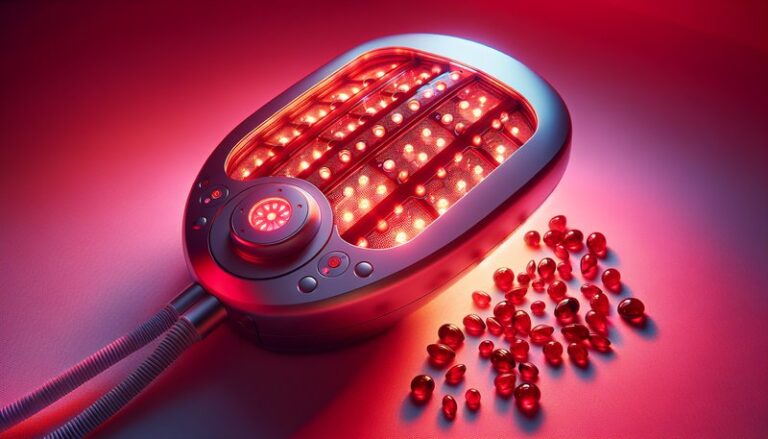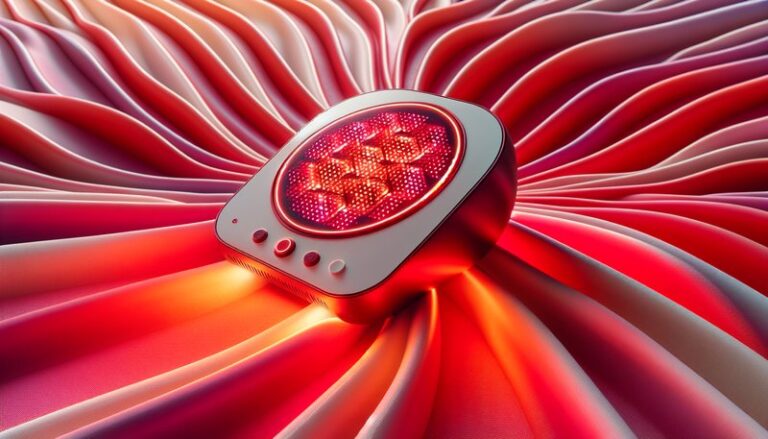What Does Red Light Therapy Do For Weight Loss?
Have you ever wondered how some people effortlessly shed pounds while others struggle? Could the innovative technology of red light therapy play a role in weight loss?
In this article, we’ll explore the effects of red light therapy on weight loss, examining its mechanisms, benefits, and considerations before adopting this treatment. You’ll gain insights into how this cutting-edge method could support your weight loss journey.
Discover the full story Does Red Light Therapy Boost Blood Flow?
Key Takeaways
- Red light therapy may enhance fat metabolism and reduce inflammation, contributing to weight loss.
- It can improve muscle recovery and performance, enabling more effective workouts.
- While promising, the therapy should complement a balanced diet and exercise for optimal results.
What is Red Light Therapy?
Red light therapy (RLT) is a non-invasive treatment that utilizes low-wavelength red light to stimulate cellular function. This form of therapy is believed to energize cells, hence promoting healing, reducing inflammation, and supporting processes like fat metabolism.
Historically, red light therapy was first adopted in medical settings, particularly for wound healing and pain relief. Over time, its application has expanded, and many now turn to it for various aesthetic and health benefits, including weight loss.
How Red Light Therapy Works
Red light typically falls within the wavelength range of 600 to 650 nanometers. When applied to the skin, it penetrates deeper layers, stimulating the mitochondria—often referred to as the powerhouse of cells. This stimulation enhances ATP production (adenosine triphosphate), which fuels cellular processes, including fat breakdown and muscle recovery.
What are the Benefits of Red Light Therapy?
Utilizing red light therapy in weight loss regimens offers several promising advantages. Let’s delve into these benefits in more detail.
Enhanced Fat Metabolism
Research indicates that red light therapy can increase mitochondrial activity in adipocytes, or fat cells. By promoting more efficient fat breakdown, this may result in a reduction in body fat over time.
Reduced Inflammation
Chronic inflammation can hinder weight loss efforts. Red light therapy has been shown to reduce markers of inflammation, potentially improving one’s ability to lose weight and maintain health.
Improved Muscle Recovery
For individuals who engage in regular exercise, red light therapy can significantly speed up muscle recovery. Enhanced recovery allows for more frequent and intensive workouts, further supporting metabolic rates and continued weight loss.
Supports Healthy Hormone Levels
Red light therapy may influence hormone levels, including those that regulate metabolism, appetite, and energy levels. Achieving a healthy hormonal balance can be crucial for effective weight loss.
Non-Invasive Treatment Method
Unlike surgical weight loss options, red light therapy is non-invasive, making it an accessible choice for many people. It comes with minimal side effects, making it a low-risk option to incorporate alongside other weight loss strategies.
Is it Possible to Lose Weight with Red Light Therapy?
While red light therapy shows promising potential for aiding weight loss, it is essential to understand that it is not a standalone solution. This treatment works best when integrated into a holistic weight loss plan, including a balanced diet and regular physical activity.
What are the Advantages of Integrating RLT into Your Routine?
Incorporating red light therapy into your weight loss efforts can provide several advantages:
Boosts Motivation
The positive results from red light therapy may encourage you to stick to your weight loss plan. Seeing progress can enhance motivation to maintain healthy lifestyle choices.
Convenience
With sessions often taking as little as 10–20 minutes, red light therapy is a convenient addition to your routine, fitting easily into busy schedules.
Enhances Overall Wellness
By improving recovery and reducing inflammation, red light therapy can contribute to overall wellness, increasing your overall quality of life while you focus on weight management.
What are the Disadvantages of Red Light Therapy?
Though beneficial, there are also downsides to consider with red light therapy:
Limited Immediate Results
Many users may not experience immediate weight loss results, which can be discouraging. Consistency and patience are crucial.
Not a Replacement for Exercise and Diet
Red light therapy should not replace traditional weight loss methods like healthy eating and exercise. It works best as a complementary treatment.
Cost of Treatments
Depending on where you go for therapy, costs can be a concern. Regular sessions may add up, so it’s essential to weigh the financial commitment against potential benefits.
What are the Things to Consider Before Trying Red Light Therapy?
Before embarking on a red light therapy journey, consider the following factors to ensure it aligns with your goals:
Consult with a Healthcare Professional
Always consult with a doctor or a qualified healthcare provider before starting any new treatment, especially if you have underlying health issues or are pregnant.
Research Qualified Providers
Ensure you choose a reputable clinic or provider with experience in red light therapy. Look for certifications and reviews from other clients.
Combine with a Structured Plan
Entrench red light therapy within a well-structured plan that includes nutritional guidance and physical activity for optimal results.
Understand Individual Differences
Keep in mind that individual results may vary. What works for one person may not yield the same results for another.
What are the Alternatives to Red Light Therapy?
If red light therapy does not seem like an ideal fit for your weight loss strategy, several alternatives are available:
Read the thorough analysis Can Red Light Therapy Aid Weight Loss?
Cryotherapy
Cryotherapy involves exposing the body to extreme cold, which can boost metabolism and assist in weight loss. This method also helps reduce inflammation and improve recovery.
Ultrasound Fat Reduction
Ultrasound fat reduction treatments use sound waves to target and break down fat cells. This method can result in visible fat loss in targeted areas.
Infrared Sauna Therapy
Infrared saunas can promote sweating and detoxification, potentially assisting in weight loss. The heat can also help with muscle recovery post-exercise.
Dietary Adjustments
Modifying your diet to include whole, nutrient-dense foods while reducing processed foods can significantly impact your weight loss journey without the need for additional therapies.
Conclusion: Is it Recommended to Use Red Light Therapy for Weight Loss?
Red light therapy can be a valuable tool in the weight loss arsenal, particularly for those looking to enhance the effects of diet and exercise. However, it is not a panacea and should be considered a complementary treatment rather than a standalone solution. Engaging with a healthcare provider and creating a comprehensive plan can optimize your success.
Frequently Asked Questions
Is red light therapy safe for everyone?
Red light therapy is generally considered safe for most individuals. However, those with specific health conditions should consult a healthcare professional before beginning treatment.
How long does it take to see results from red light therapy?
Results can vary widely depending on the individual and the specific goals. Some may notice improvements in energy and recovery within a few sessions, whereas noticeable weight loss may take weeks or months.
Can I perform red light therapy at home?
Yes, there are at-home devices available for red light therapy. However, it’s essential to ensure these devices meet safety and efficacy standards.
How often should I undergo red light therapy for weight loss?
Most recommendations suggest 3-5 sessions per week. However, your regimen may differ based on individual goals and responses.
Are there any side effects of red light therapy?
Red light therapy generally has minimal side effects, but some users may experience mild skin irritation or temporary redness. Always monitor your body’s response and adjust as necessary.





